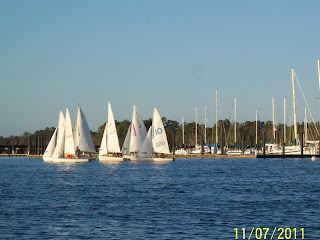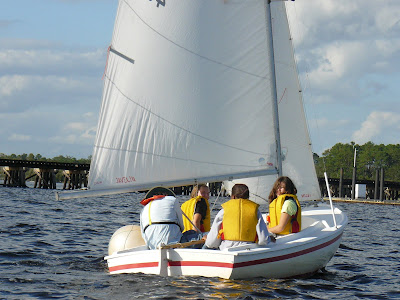.

Your textbook (handout) discusses BOUYANCY and STABILITY. These two must be understood, if you want to predict how a vessel will react in a given situation.
But right now, let's go with the understanding that any vessel can capsize. How are you going to cope when it happens to your
FJ?
.
Here are the basic steps:
... ... ... ... ... ... ... ... ... ... ... ... ... ... ... ... ... ... ... ... ... ... ... ... ... ... ... ... ... ... ...
 1- ensure that your skipper/crew are OK.
1- ensure that your skipper/crew are OK.
... ... ... ... ... ... ... ... ... ... ... ... ... ... ... ... ... ... ... ... ... ... ... ... ... ... ... ... ... ... ...
 2- get control of the boat... keep it from turning turtle (skipper holds the centerboard)
2- get control of the boat... keep it from turning turtle (skipper holds the centerboard)
.
... ... ... ... ... ... ... ... ... ... ... ... ... ... ... ... ... ... ... ... ... ... ... ... ... ... ... ... ... ... ...
 3- when ready, pull the boat upright (crew does the "scoop"). Start sailing again!
(note- this shows the crew already in the boat... the proper SCOOP method will be detailed later)
3- when ready, pull the boat upright (crew does the "scoop"). Start sailing again!
(note- this shows the crew already in the boat... the proper SCOOP method will be detailed later)
... ... ... ... ... ... ... ... ... ... ... ... ... ... ... ...
... ... ... ... ... ... ... ... ... ... ... ... ... ... ...
These 3 simple steps should be easy to remember. Unfortunately, real life usually gets a bit more complicated. Before going into complications, let's look at what NOT to do!
Do NOT abandon your crew or skipper
Do NOT leave the boat, attempting to swim to shore
Do NOT attempt to pull the boat upright until ready, and you are sure you can keep control of it (note- this is important, because capsizes often occur due to circumstances that make the boat difficult or impossible to control, such as violent squalls)
Do NOT climb up the cockpit, or stand on the rig.
(note- this is important, because capsizes often occur due to circumstances that make the boat difficult or impossible to control, such as violent squalls)
Do NOT climb up the cockpit, or stand on the rig.
... ... ... ... ... ... ... ... ... ... ... ... ... ... ... ... ... ... ... ... ... ... ... ... ... ... ... ... ... ... ...
Now let's go into some more detail about each of those steps. In theory, it will go just fine as long as you follow the simple procedure. In reality, we all know that stuff gets complicated.
... ... ... ... ... ... ... ... ... ... ... ... ... ... ... ... ... ... ... ... ... ... ... ... ... ... ... ... ... ... ...
1- Check on each other's safety, make sure each person on board is OK.
This is pretty straight forward. It obviously requires that you look after your own safety too.
If you sit in the right place on the boat, you are less likely to be entangled or struck.
This is one time where it is OK to yell... make sure you can be heard! However, be careful to not contribute to panic
If a person is not OK, then obviously your new top priority is to help them. Get their head above water and make sure they're breathing. Signal for help from the coach boat
(4 long blasts on your whistle).
... ... ... ... ... ... ... ... ... ... ... ... ... ... ... ... ... ... ... ... ... ... ... ... ... ... ... ... ... ... ...
2- Get control of the situation...
yeah, this is where it can get complicated. Don't get wrapped up in petty details, though!

A primary concern is to prevent the boat from turtling. For one thing, the Neuse River is not deep enough and the mast will stick in the mud. The skipper can swim quickly around the stern & grab the centerboard, just holding it.
What if you are hiking out when the boat capsizes, and you're sitting on the high side? This is OK, if you're careful you can swing around to the bottom of the hull & place some weight on the centerboard easily & quickly.
This pic shows a perfectly acceptable position... if you end up there naturally. Just don't try to climb there! Also, the hull is slippery, so be careful to not fall.

In strong winds and/or choppy waves, it may be necessary to have the crew swim to the bow of the boat & hold it into the wind. Also, if necessary you can lower the sails while the boat is on it's side. Try to roll them up neatly & tie them into place securely, you'll want them in good shape later!
.

You may have been told "Never bounce on the centerboard" which is correct. It's strong but it is possible to break the centerboard. A broken 'board leaves you in a MUCH worse situation!
.

Another problem can be sheets. If the sails are pulled in tight & the sheet tangled, you can see that the sails are going to try & hold a LOT of water, making the boat difficult to pull upright. The crew should make sure that both sails are free. What could be worse? Pulling the boat upright with the sheets tangled, so that it immediately capsizes again... harder this time!
.
OK, everything is under control! The boat is held steady on it's side, the crew has finished trouble-shooting everything that can go wrong, the skipper is ready to pull the boat upright, the crew is ready to 'scoop' aboard...
.

So, how do we SCOOP?
This is a method of bringing the boat upright with the crew already on board & ready to keep control, and also able to help the other person(s) back aboard promptly.
The key is to NOT impede the righting of the boat. In this picture, one person is pulling the boat upright (and the sails are already rising out of the water freely), and the other is ready to "scoop" by holding securely (the hiking strap is a good hand-hold) BUT is still floating or treading water.
.

Note that if the FJ is handled properly through the capsize drill, it will come up without any water inside.
As the boat continues to turn upright, the crew pulls/swims up into the boat. Be careful of metal points & hard edges. When the boat is fully upright, the crew should be securely inside & ready to help get the skipper aboard.
When you consider everything that can go wrong, the capsize is daunting. However if you follow the simple steps in order, and troubleshoot problems within the sequence of following these steps, you should be able to get the boat under control, keep it under control, and resume sailing.
.







 body got to vote on the HOTTEST, the BEANIEST (is this good?), and the overall BEST chili. Although Coach King's chili, which featured curry as one of the spices, was the first to disappear, it did not get any votes. Bob's Oktoberfest Chili was almost unanimously voted the 'Best Overall' even though it was almost sweet rather than spicy-hot.
body got to vote on the HOTTEST, the BEANIEST (is this good?), and the overall BEST chili. Although Coach King's chili, which featured curry as one of the spices, was the first to disappear, it did not get any votes. Bob's Oktoberfest Chili was almost unanimously voted the 'Best Overall' even though it was almost sweet rather than spicy-hot.




 rescue demonstration by the Marine Corps HH-46 helicopter & Coast Guard crews.
rescue demonstration by the Marine Corps HH-46 helicopter & Coast Guard crews.


 This was a longer day of sailing than our usual training sessions. The sailing cadets got to stop in town (thanks to the Galley Store (link) who kindly let us use their dock) and also met the Coast Guardsmen on their 41-ft vessel.
This was a longer day of sailing than our usual training sessions. The sailing cadets got to stop in town (thanks to the Galley Store (link) who kindly let us use their dock) and also met the Coast Guardsmen on their 41-ft vessel.








 Your textbook (handout) discusses BOUYANCY and STABILITY. These two must be understood, if you want to predict how a vessel will react in a given situation.
Your textbook (handout) discusses BOUYANCY and STABILITY. These two must be understood, if you want to predict how a vessel will react in a given situation.




















